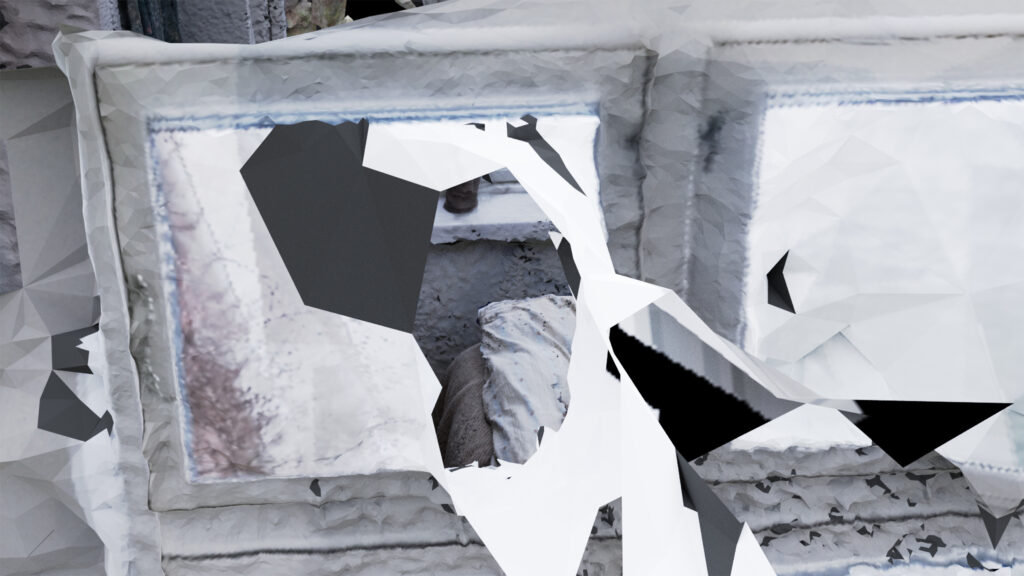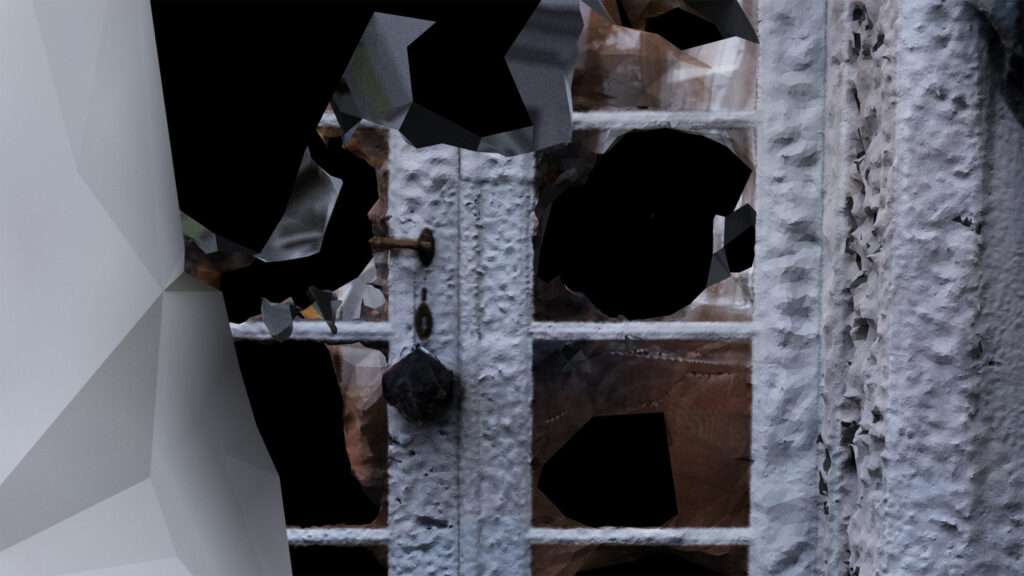

Touched by Digital Tears
In November, I spent several days merging two 3D maps over different areas of my hometown, Aarhus, into one. The files were so large that the software continuously crashed, and I had to start over. This went on for quite some time. When I managed to save the map as only one file, little glitches and black spots appeared in the 3D-mesh due to my computer not being able to process the high amount of data.
Another time, I photographed every corner of a room (see images). I dragged all the photos into this miracle program that turns photographs into 3D models. Once I pressed “start”, I had no control over how the software related the different parts of the room to each other. I had tried to affect the result by making tiny overlaps between each image when photographing. But as I anticipated, after six hours of processing, the room did not appear naturalistic. Even larger black holes had emerged, pieces of furniture were cut in half and walls gradually crackled into the grey background. The characteristics of the room had completely changed. They had been turned into what seemed like a dystopian, crackled Renaissance painting. However, I realized that I liked its new look. It contained an aesthetic that I would not have thought of pursuing myself.
Something happens in the interaction between me and the digital software which is difficult to dismantle. In the introduction to New Materialisms: Ontology, Agency and Politic, theorists Diana Coole and Samantha Frost criticize the tendency to understand “even the most apparently natural phenomena” as something dependent on relations of power.[1] They stress how the focus on language, discourse, culture and values leads to a neglect of materiality and its reality: “Our motivation in editing this book has been a conviction that it is now time to subject objectivity and material reality to a similarly radical reappraisal”.[2] Hereby, they argue for a subjectivity of materiality that is equal to external matters. Instead of searching for materiality’s connection to language, discourse etc., it is time to understand materiality as a phenomenon of its own not necessarily rooted in the above. Materiality holds its own agency, which should be equally considered.
The digital properties are agents in determining the outcome of the sum of my photos. In the process of making a 3D model, different aspects should be considered: the camera equipment, the sunlight, the artificial lighting in the room, the photographer, the software, the computer, and so on and so forth. All these are agents, each with their agency contained in the model of the room in Aarhus. It is not solely I who decide the outcome of a given piece of art, or even a plate of spaghetti bolognaise. The crackled walls are a result of several agents, and it is the reaction of these which creates its specific aesthetics and expression. But how does the digital succeed in communicating emotions even though it is basically created by code?
Ed Atkins’ art piece Old Food is a digital 3D animation with CGI [3] characters playing the piano and crying. I am touched by their actions. When I look at the work, I notice some of the “digital glitches” that I mentioned in the beginning of this text. The character’s walk is awkward and mechanical, and the lighting is unnatural. Instead of pursuing a more “human-like” walk or trying to replicate natural light sources, the properties of the digital software are emphasized. The code becomes a dominant agent in the aesthetics of the piece. According to Frost and Coole, the materiality gets its own subjectivity equal to the subjectivity of the other agents present in the work. This is what feminist theorist Karen Barad refers to as “agential realist ontology”:
(…) a causal relationship between specific exclusionary practices embodied as specific material configurations of the world (…) and specific material phenomena (…) This causal relationship between the apparatuses of bodily production and the phenomena produced is one of “agential intra-action.”[4]
These relationships are “intra-actions” of different agents causing different phenomena. In the case of Old Food, the code, the classical music, the lighting and the viewer each hold their agency. It is the relationship between these that is the aesthetics of Old Food and the cause of my emotional experience of it. The computer-generated tears touch me, since they are not only code, but all the above.
Referenslista
[1] Coole, Diana and Frost, Samantha. (red.). New Materialisms: Ontology, Agency and Politics. Durham and London: Duke University Press, 2010. p. 2.
[2] Ibid. p. 2.
[3] Computer-generated imagery
[4] Barad, Karen. Posthumanist Performativity: Toward an Understanding of How Matter Comes to Matter. Journal of Women in Culture and Society. Vol. 28, no. 3, 2003: 801-831. p. 814.
Bilder Cecilia Penney